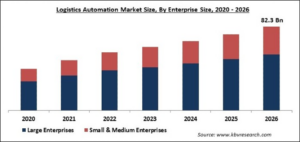
The global logistics automation market has been growing at a Compound Annual Growth Rate (CAGR) of 12.4% since 2020, the highest growth rate of any supply chain market. By 2026, the global logistics automation market is estimated to reach $82.3 Billion. These figures reflect the aggressive pace at which businesses have been incorporating advanced technologies to automate their supply chain operations.


With businesses transitioning to automated workflows, data is the most useful entity in modern supply chain networks. While automation reduces costs and increases speed to enhance efficiency, it comes with its own challenges. The implementation of multiple new technologies may add to the complexity of supply chain systems. The biggest challenge, however, is data silos. Inconsistent data is equally as fatal as the absence of data for supply chains.
Data errors may affect the ability to understand customer requirements and make informed decisions. Thus, ensuring consistent storage, processing and management of data is as crucial as embracing automation to enhance supply chain efficiency.
The Importance of Data In Supply Chain Management
Access to organized data helps businesses take proactive actions for the efficient supply chain management. It aids in accurate demand forecasting and efficient risk management. Amidst increasing competition in the global economy, businesses must transition from reactive to proactive supply chains to gain a competitive advantage and expand.


Image source: ScienceDirect.com
Analysis of supplier data, customer data, inventory levels, transportation costs, and other factors help improve efficiency and reduce costs. With access to data-based actionable insights, businesses can optimize inventory levels, reduce transportation costs, and improve delivery times. With the right data and analytics tools, supply chain managers can identify trends and patterns that are otherwise difficult to spot.


Image source: https://appinventiv.com/blog/ai-in-supply-chain-analytics/
Here’s how data-driven logistics helps build a proactive supply chain:
Forecasting Demands Accurately: Rapidly changing customer demands are among the biggest challenges for modern supply chains. The usual approach is to wait for demands and take action accordingly. But with demands changing faster than ever, it may lead to wastage or failure to fulfilment.
Data-driven supply chain management involves advanced analytics-powered supply chain management, which helps forecast demand accurately and helps control inventory levels accordingly.
Risk Reduction: Disruptions are a frequently occurring phenomenon, and they are here to stay. Instead of waiting for a disaster to happen, it is wiser to incorporate a data-driven decision-making mechanism. Technologies like AI and advanced analytics have the capability to study data models and predict disruptions.
With a warning of disruption, supply chain leaders have ample time to devise a risk management mechanism and minimize the impact.
Quality Control: Supply chains often deal with temperature-sensitive materials. Especially for food supply chains, it is highly important to take care of factors like temperature, air pressure and precipitation.
Data-based analysis helps you find out the exact reasons behind spillage or damaged products. Once it is known the exact reasons behind quality damage, stakeholders can take the necessary steps to enhance quality.
Technology is an enabler of data-driven supply chain management. Advanced technologies, like machine learning and artificial intelligence, can help companies identify patterns and trends in supply chain data that would be difficult or impossible to detect manually. Predictive analytics can help companies anticipate changes in demand and adjust their supply chain accordingly. Supply chain visibility tools can provide real-time insights into inventory levels, transportation routes, and delivery times. IoT sensors and RFID tags can help track the movement of goods and provide data on conditions such as temperature, humidity, and handling.
But how does one maximize the impact of a data-driven supply chain?
There are certain factors that must be considered before making the transition. To build a data-driven supply chain, supply chain managers must choose the right technology and the right solutions. Most importantly, leadership must educate team members about different sophisticated systems to ensure that the transition to automation is smooth.
How To Optimize Your Supply Chain Using Data
- Build a data-driven culture by promoting data awareness, developing a strategy, and gaining buy-in from all levels of the organization.
- Prioritize business use cases that will generate the most benefit and are solvable with available data and skills.
- Define KPIs to measure progress in achieving the business objectives. It is highly important to track the KPIs to evaluate if your efforts are bearing the desired results.
- Invest in a data platform that integrates and manages data, supports analytics, and provides real-time insights into all aspects of the supply chain.
- Use advanced analytics, such as machine learning, to identify patterns and trends in data and optimise various aspects of the supply chain.
- Collaborate with suppliers and partners by sharing data and insights to improve supply chain efficiency and develop innovative products and services.
- Train and educate employees in advanced analytics techniques, particularly artificial intelligence, to derive greater value from supply chain data and make full use of the available talent pool.
Final Word
Data-driven supply chain management is the way forward to tackle disruptions and keep outages at bay. But, to maximize the ROI for tech-enabled supply chain automation, supply chain leadership must choose the right technologies and the right solution. It is equally important to build a culture and educate the team for a seamless transition from reactive to proactive supply chain management. With demands fluctuating more frequently, building a data-driven supply chain is critical to meet your business goals and outperform your competitors.
Author Bio:
Dan Weinberger-
UN Supply Chain Expert and CEO of Morpheus.Network Twitter Linkedin
- SEO Powered Content & PR Distribution. Get Amplified Today.
- EVM Finance. Unified Interface for Decentralized Finance. Access Here.
- Quantum Media Group. IR/PR Amplified. Access Here.
- PlatoAiStream. Web3 Data Intelligence. Knowledge Amplified. Access Here.
- Source: https://www.allthingssupplychain.com/harness-the-power-of-data-to-optimize-your-supply-chains/?utm_source=rss&utm_medium=rss&utm_campaign=harness-the-power-of-data-to-optimize-your-supply-chains
